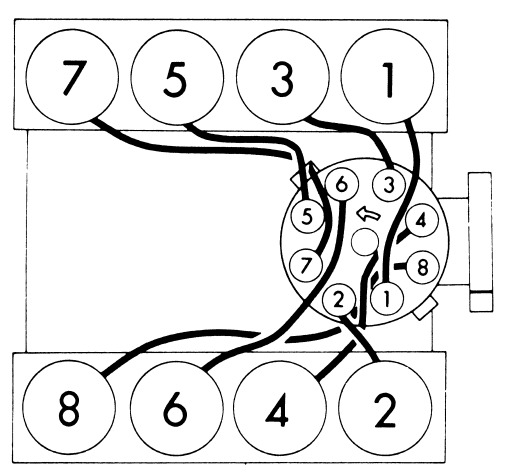The Mopar 383 engine, part of Chrysler’s Big Block “B” engine family, is renowned for its power and reliability. Found in iconic vehicles like the Dodge Charger, Plymouth Road Runner, and other classic muscle cars, the Mopar 383 relies on a precise firing order to deliver smooth operation and performance.
In this guide, we’ll break down everything you need to know about the Mopar 383 firing order, its significance, and how to maintain it.

Quick Navigation
What is a Firing Order?
The firing order refers to the sequence in which an engine’s cylinders ignite their air-fuel mixture during the combustion process. For a V8 engine like the Mopar 383, the firing order is 1-8-4-3-6-5-7-2.

This specific sequence ensures the engine operates efficiently, delivering balanced power and minimizing vibrations. Let’s explore why this sequence is critical and how it works within the Mopar 383.
Why the Firing Order is Important
The firing order is essential to the overall functionality of the Mopar 383 engine. Here are the key reasons it matters:
- Engine Balance: The proper sequence minimizes vibrations and ensures smooth operation.
- Power Delivery: The firing order ensures consistent torque, resulting in smooth acceleration.
- Efficiency: A correct firing order allows for complete combustion, improving fuel economy and reducing emissions.
- Durability: Balanced operation reduces stress on engine components, enhancing longevity.
- Smooth Performance: An accurate firing order prevents misfires, ensuring reliable engine operation.
Disrupting the firing order can lead to problems such as misfires, rough idling, and loss of power.
The Mopar 383 Firing Order: 1-8-4-3-6-5-7-2
The Mopar 383 engine follows the firing order 1-8-4-3-6-5-7-2. Let’s break it down step by step:
- Cylinder 1 Fires First: The sequence starts with Cylinder 1, where the spark plug ignites the air-fuel mixture.
- Cylinder 8 Fires Next: Cylinder 8 takes over, maintaining smooth power delivery.
- Cylinder 4 Ignites: Cylinder 4 fires, contributing to balanced operation.
- Cylinder 3 Engages: Cylinder 3 follows, continuing the sequence.
- Cylinder 6 Fires: Cylinder 6 takes its turn in the firing cycle.
- Cylinder 5 Engages: Cylinder 5 ignites, maintaining the engine’s rhythm.
- Cylinder 7 Fires: Cylinder 7 follows, balancing the firing sequence.
- Cylinder 2 Completes the Cycle: Finally, Cylinder 2 fires, and the sequence repeats.
This firing order is carefully designed to optimize the V8 engine’s performance and balance.
How the Firing Order Works in the Mopar 383
The Mopar 383 engine operates on a four-stroke cycle, consisting of the following stages:
- Intake Stroke: The air-fuel mixture enters the cylinder as the intake valve opens.
- Compression Stroke: The piston compresses the mixture, preparing it for ignition.
- Power Stroke: The spark plug ignites the mixture, driving the piston downward and generating power.
- Exhaust Stroke: The exhaust valve opens, expelling the spent gases.
The firing order coordinates these stages across all eight cylinders, ensuring smooth and continuous power delivery. The 1-8-4-3-6-5-7-2 sequence evenly distributes the workload, reducing engine strain and maximizing performance.
Components Supporting the Firing Order
Several components ensure the Mopar 383’s firing order is maintained. Here’s how they contribute:
- Crankshaft: Converts the pistons’ linear motion into rotational energy, dictating the sequence of power strokes.
- Camshaft: Controls the timing of the intake and exhaust valves, synchronizing them with the firing order.
- Distributor: Sends electrical signals to the spark plugs in the correct sequence to ignite the air-fuel mixture.
- Spark Plugs: Ignite the mixture in each cylinder at the right moment.
- Timing Chain/Belt: Synchronizes the crankshaft and camshaft, ensuring the firing order is executed correctly.
When these components work together seamlessly, the engine operates smoothly and efficiently.
Symptoms of Firing Order Issues
If the firing order is incorrect or disrupted, the engine will exhibit several noticeable symptoms. Here are the most common issues:
- Engine Misfires: Cylinders fail to ignite properly, causing uneven power delivery.
- Rough Idling: The engine may run inconsistently or vibrate excessively at idle.
- Loss of Power: An incorrect firing order reduces efficiency, resulting in sluggish acceleration.
- Backfiring: Faulty timing may cause combustion gases to ignite in the intake or exhaust system.
- Excessive Vibrations: An imbalanced firing sequence creates noticeable vibrations during operation.
Addressing these problems promptly is critical to prevent further engine damage.
How to Verify the Firing Order
To ensure the Mopar 383’s firing order is correct, follow these steps:
- Check Spark Plug Wires: Verify that each wire is connected to the correct cylinder and distributor terminal based on the firing order.
- Inspect the Distributor Cap: Ensure the cap is properly aligned and in good condition.
- Use a Timing Light: A timing light can confirm that each spark plug fires at the correct moment.
- Consult the Service Manual: Refer to the Mopar 383 service manual for the correct wiring diagram and firing sequence.
- Listen for Unusual Sounds: Sputtering, knocking, or irregular engine noises may indicate a firing order issue.
Routine checks help maintain the firing order and keep the engine running smoothly.
Maintaining the Firing Order
Regular maintenance is essential to preserving the Mopar 383’s firing order and ensuring optimal engine performance. Here are some tips:
- Replace Spark Plugs: Worn spark plugs can cause misfires and disrupt the firing sequence.
- Inspect the Ignition System: Check the distributor, ignition coil, and spark plug wires for wear or damage.
- Monitor the Timing Chain/Belt: Ensure the timing mechanism is correctly aligned and tensioned to avoid disruptions.
- Perform Routine Tune-Ups: Regular inspections and adjustments prevent firing order issues.
- Use High-Quality Fuel: Clean-burning fuel minimizes carbon buildup, improving combustion efficiency.
Following these practices will help maintain the engine’s reliability and performance.
Can You Modify the Firing Order?
The Mopar 383’s firing order, 1-8-4-3-6-5-7-2, is specifically designed for the engine’s V8 configuration. Modifying this sequence is not advisable because:
- Imbalance Issues: Altering the firing order can cause excessive vibrations and instability.
- Reduced Efficiency: An incorrect sequence disrupts combustion, resulting in power loss and increased fuel consumption.
- Potential Damage: Changing the firing order can stress internal components, leading to long-term damage.
For performance improvements, consider upgrades like optimizing the ignition system, improving the intake and exhaust, or tuning the carburetor, rather than altering the firing order.
Conclusion
The Mopar 383’s firing order, 1-8-4-3-6-5-7-2, is a fundamental aspect of its legendary V8 engine design. This precise sequence ensures smooth power delivery, balanced operation, and efficient combustion. Understanding how the firing order works and maintaining it is key to keeping the engine reliable and performing at its best.
By following regular maintenance practices, checking for signs of firing order issues, and using high-quality components, you can preserve the performance and longevity of your Mopar 383 engine. Whether you’re restoring a classic muscle car or maintaining a daily driver, adhering to the correct firing order ensures the iconic power and dependability of this legendary engine.

